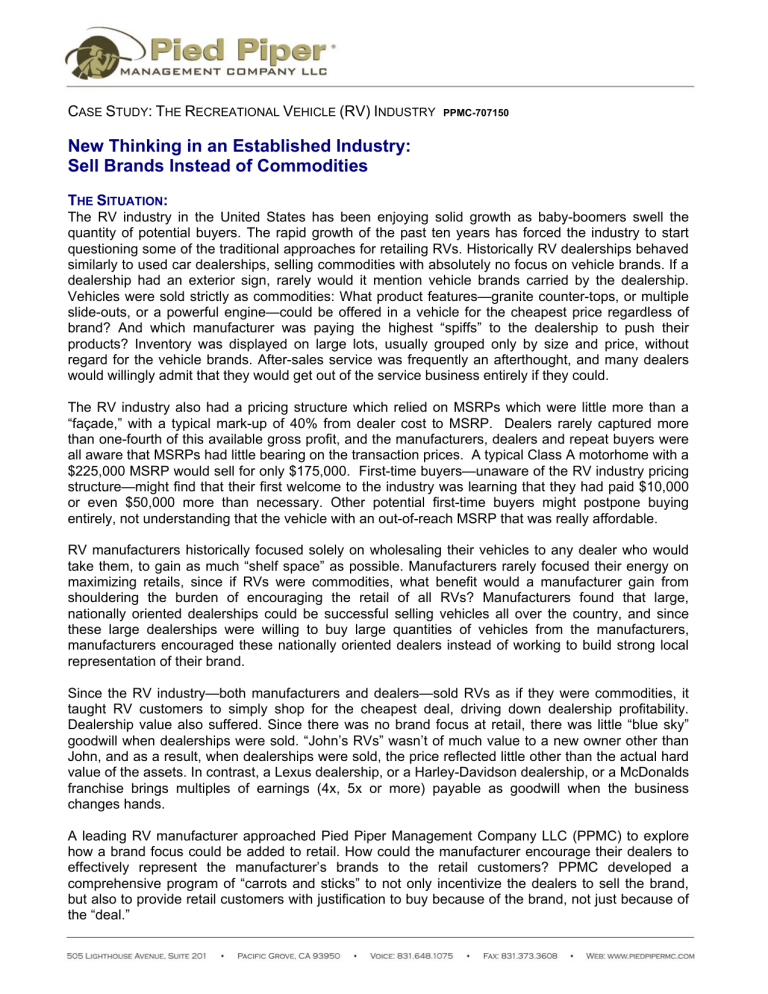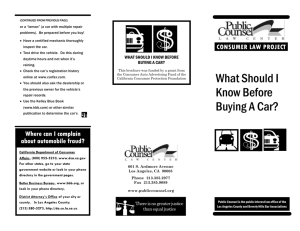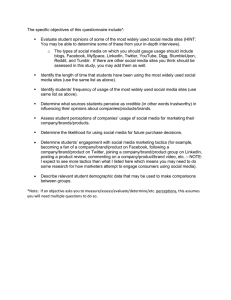New Thinking In An Established Industry

C ASE S TUDY : THE R ECREATIONAL V EHICLE (RV) I NDUSTRY P IED P IPER M ANAGEMENT C OMPANY , LLC w w w. p i e d p i p e r m c. c o m
C ASE S TUDY : T HE R ECREATIONAL V EHICLE (RV) I NDUSTRY PPMC-707150
New Thinking in an Established Industry:
Sell Brands Instead of Commodities
T HE S ITUATION :
The RV industry in the United States has been enjoying solid growth as baby-boomers swell the quantity of potential buyers. The rapid growth of the past ten years has forced the industry to start questioning some of the traditional approaches for retailing RVs. Historically RV dealerships behaved similarly to used car dealerships, selling commodities with absolutely no focus on vehicle brands. If a dealership had an exterior sign, rarely would it mention vehicle brands carried by the dealership.
Vehicles were sold strictly as commodities: What product features—granite counter-tops, or multiple slide-outs, or a powerful engine—could be offered in a vehicle for the cheapest price regardless of brand? And which manufacturer was paying the highest “spiffs” to the dealership to push their products? Inventory was displayed on large lots, usually grouped only by size and price, without regard for the vehicle brands. After-sales service was frequently an afterthought, and many dealers would willingly admit that they would get out of the service business entirely if they could.
The RV industry also had a pricing structure which relied on MSRPs which were little more than a
“façade,” with a typical mark-up of 40% from dealer cost to MSRP. Dealers rarely captured more than one-fourth of this available gross profit, and the manufacturers, dealers and repeat buyers were all aware that MSRPs had little bearing on the transaction prices. A typical Class A motorhome with a
$225,000 MSRP would sell for only $175,000. First-time buyers—unaware of the RV industry pricing structure—might find that their first welcome to the industry was learning that they had paid $10,000 or even $50,000 more than necessary. Other potential first-time buyers might postpone buying entirely, not understanding that the vehicle with an out-of-reach MSRP that was really affordable.
RV manufacturers historically focused solely on wholesaling their vehicles to any dealer who would take them, to gain as much “shelf space” as possible. Manufacturers rarely focused their energy on maximizing retails, since if RVs were commodities, what benefit would a manufacturer gain from shouldering the burden of encouraging the retail of all RVs? Manufacturers found that large, nationally oriented dealerships could be successful selling vehicles all over the country, and since these large dealerships were willing to buy large quantities of vehicles from the manufacturers, manufacturers encouraged these nationally oriented dealers instead of working to build strong local representation of their brand.
Since the RV industry—both manufacturers and dealers—sold RVs as if they were commodities, it taught RV customers to simply shop for the cheapest deal, driving down dealership profitability.
Dealership value also suffered. Since there was no brand focus at retail, there was little “blue sky” goodwill when dealerships were sold. “John’s RVs” wasn’t of much value to a new owner other than
John, and as a result, when dealerships were sold, the price reflected little other than the actual hard value of the assets. In contrast, a Lexus dealership, or a Harley-Davidson dealership, or a McDonalds franchise brings multiples of earnings (4x, 5x or more) payable as goodwill when the business changes hands.
A leading RV manufacturer approached Pied Piper Management Company LLC (PPMC) to explore how a brand focus could be added to retail. How could the manufacturer encourage their dealers to effectively represent the manufacturer’s brands to the retail customers? PPMC developed a comprehensive program of “carrots and sticks” to not only incentivize the dealers to sell the brand, but also to provide retail customers with justification to buy because of the brand, not just because of the “deal.”
C ASE S TUDY : THE R ECREATIONAL V EHICLE (RV) I NDUSTRY P IED P IPER M ANAGEMENT C OMPANY , LLC w w w. p i e d p i p e r m c. c o m
T HE A PPROACH :
Measure, Measure, Measure
The first question was whether RV buyers cared about RV brands. We carried out the industry’s first
“purchase funnel” research: measuring awareness of brand and product; familiarity, opinion, consideration, purchase intention, shopping and purchase. We found that despite the history of manufacturers and dealers selling RVs as commodities, the buyers of at least Class A RVs (the large bus-like motorhomes) had clear preferences for certain brands, and understood unique attributes associated with a brand. What’s more, we measured price elasticity, and found that many buyers who preferred certain brands were willing to pay more for them if necessary. We also measured dealer satisfaction, profitability, performance and analyzed the network. After understanding the RV market we looked to similar industries for lessons learned in their holdback and facility programs.
Influence
Our measurements showed us the reasons why and how buyers purchase RVs and showed us our client’s strengths and weaknesses within the industry. The output was a clear understanding of what variables to influence. In particular, we discovered that an acceptably high percentage of customers for our clients brands were still willing to purchase even if the transaction price were slightly higher. We forced the transaction price higher by increasing the dealer invoice price, while leaving MSRP fixed. Dealers simply passed along what to them was a p rice increase, keeping the same dealership gross profit as before, but resulting in a slightly higher transaction price to the retail buyer.
We were then able to use the funds raised from increasing the dealer invoice to create dealership incentive programs to install brand signage and interior brand sales materia ls, to train the dealership sales force, and to boost the overall effectiveness of brand representation at the dealerships.
Profit
The primary goal of our initiatives was not only to boost client profitability through continual growth in sales and market share, but also specifically to boost dealership profitability and value. Our client understood that a profitable dealer body was necessary in order to attract and maintain the best dealer representation. The net effect of our initiatives was an 85% increase in dealership per-vehicle profitability and record market share for our client, during a challenging time for the RV industry, with rapidly rising interest rates and fuel prices, coupled with declining consumer confidence.
T HE R ESULT
Two years after kicking-off this initiative for our client, 90%+ of our client’s dealerships featured brand signage and interior brand displays, and 100% had completed sales training to focus attention on providing reasons to purchase other than simply chasing the cheapest deal. When we measured how retail customers were treated at our client’s dealerships before our involvement, we found that 22% of the time shoppers looking for our client’s products were pushed toward a competitive brand product instead—the commodity approach. Two years later, the dealer sales approach had changed completely, instead of a commodity approach the dealers were focused on showcasing our client’s brands. The dealers now pitched our client’s brands 95% of the time, and showed competitor products instead only 5% of the time.

